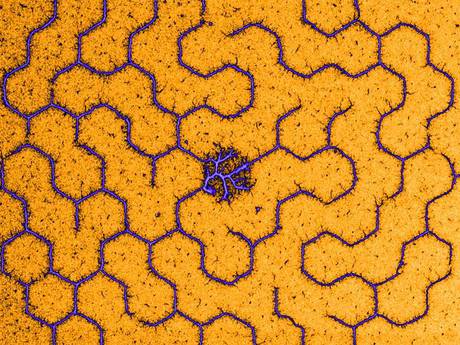DNA condensation on a biochip

Physicists have for the first time managed to artificially carry out the phenomenon of DNA condensation on a biochip. This process comes into play whenever DNA molecules are closely packed into tight spaces; for example, in circumstances that limit the available volume.
Due to their negative charge, DNA molecules normally repel each other, giving the appearance of tiny nanohairs standing on end. However, when space is limited, DNA molecules must be packed together more tightly. This situation arises in cell nuclei and in the protein shells of viruses, as well as in the heads of sperm cells. Condensation and decondensation, ie, the renewed unpacking of DNA strands, play an important role in processes like gene expression.
Researchers at Germany’s TU Munich and Israel’s Weizmann Institute sought to replicate the process of DNA condensation by bonding DNA molecules one thousandth of a millimetre long (ie, several thousand base pairs long each) tightly to nanostructures of varying widths on a chip. It looked as though the researchers had planted tiny hairs onto the chip surface.
The scientists then added an agent called spermidine, whose molecules have multiple positive charges, to the chip. The previously upright DNA threads collapsed one after the other, dropping systematically onto the fine structures of the next thread, like a domino cascade at the nanoscale. The result was compact layers of DNA molecules, packed as densely as they are in cell nuclei.
“This is a very dramatic process,” said study co-author Professor Friedrich Simmel, from TU Munich. “The DNA is instantly bundled in a single direction.”
The researchers now have a building block for creating artificial cells on the surface of chips and studying all associated phenomena, with Professor Simmel saying, “It is quite plausible to implement cell-like systems with densely packed DNA on a chip.” DNA condensation could then be used to improve the control of gene expression and copying of genetic information in these kinds of artificial cells.
In principle, it is also possible to use the densely packed DNA molecules to relay and distribute signals and information via a kind of conducting path on such biochips. Condensation and decondensation could be used as on/off switches with good temporal control.
“We also want to understand the conditions of the phase transition during condensation,” said Professor Simmel. “For this, we have ideal conditions on the chip. We can precisely control where the condensation occurs and how long it takes.”
The study has been published in the journal Nature Nanotechnology.
Platform helps accelerate synthetic and metabolic workflows
Ultrahigh-throughput, droplet-based screening had long been on Biosyntia's radar for its...
Liquid biopsy to inform non-small cell lung cancer treatment
A novel liquid biopsy test may help determine which patients with non-small cell lung cancer that...
Small-scale bioreactor helps create cultivated meat
Magic Valley scientists have utilised an Applikon bioreactor in the process of creating...







